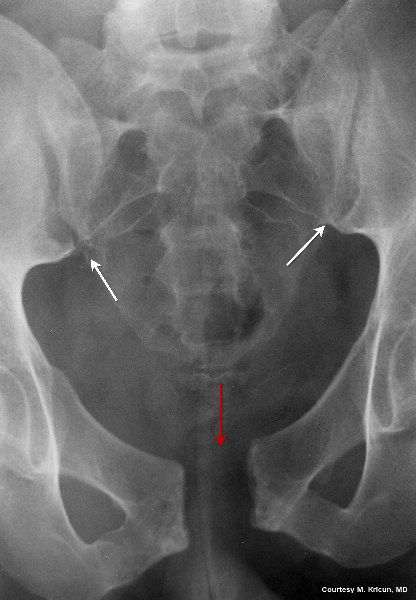|
|
Pelvic Diastasis
Sprung Pelvis, Open Book Pelvis
General Considerations
- Separation of the symphysis pubis and one or both sacroiliac joints
- Associated with injuries to the bladder and urethra, iliac vessels
- Mechanism is usually high-energy trauma such as motorcycle accidents, pedestrian-vehicle collisions, motor vehicle crashes and falls from a height exceeding 15 feet
- Force is anterior-posterior compression or forced external rotation of the legs
- The stabilizing ligaments of the pelvis are compromised
- The ligaments of the symphysis pubis are the weakest, followed by the anterior ligaments of the sacroiliac joints
- These are usually unstable fractures
Clinical Findings
- Pain
- Asymmetrical length of the lower extremities
- Crepitus
- Hematuria
Imaging Findings
- Widening of the symphysis
- Normally no more than 10 mm in children and 8 mm in non-pregnant individuals
- Greater than 2.5 cm indicates ligamentous damage at SI joint
- Widening of the sacroiliac joint (s)
- Lateral displacement of one or both innominate bones
- There is no vertical offset of the hemipelves, which would be seen with vertical shear injuries
- All radiographic findings should be further studies with CT scan
Treatment
- Reduce anterior symphyseal diastasis

Diastasis of Symphysis Pubis and both Sacroiliac Joints (Sprung Pelvis). Close-up view of the pelvis shows widening of both sacroiliac joints (white arrows), right greater than left, and marked widening of the symphysis pubis (red arrow). There is an element of vertical shear in that the hemipelves do not align vertically at the symphysis.
|
|
|